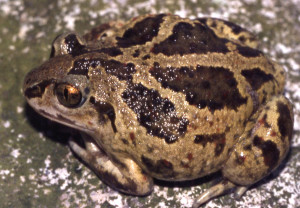Common spadefoot
 Its back is either yellow red-brown or light gray, with large and small red-brown and black spots with red dots. Its skin is smooth, and at times it can exude a noxious secretion which smells like garlic, hence the common name garlic toad. Spadefoots have characteristic spade-shaped internal protrusions on the heels of their feet, developing due to their digging activities. Another peculiarity is the vertical slit of the pupil. The toad grows up to 80 mm long, and is widespread. It is an extremely common species in the area of the Pskov-PeipsiLake. Common spadefoots migrate towards water bodies only when breeding, spending the rest of their lives ashore. They are excellent diggers, and spend most of the day dug up in soil, leaving their refuge in the evening. Due to the digging way of life, the common spadefoot is spread unevenly. They avoid stony soils. In softer land, the common spadefoot digs up very quickly and in 2-3 minutes it disappears from sight completely. It digs with hind legs, submerging with its back first almost vertically. These toads hunt at night, and the level of their activity depends directly on humidity. The higher the humidity, the more active are the spadefoots. The invertebrate species serving as forage for the garlic toad are numerous. However, a significant role in its nutrition is played by ants, ground beetles and spiders, since this species mostly does not forage in water. Amongst the native amphibians, the common spadefoot is the first to hibernate, with its wintering season lasting about 200 days. It winters ashore, digging up in soil, or using rodent holes, deep mole tunnels and nesting holes of sand martins.
Its back is either yellow red-brown or light gray, with large and small red-brown and black spots with red dots. Its skin is smooth, and at times it can exude a noxious secretion which smells like garlic, hence the common name garlic toad. Spadefoots have characteristic spade-shaped internal protrusions on the heels of their feet, developing due to their digging activities. Another peculiarity is the vertical slit of the pupil. The toad grows up to 80 mm long, and is widespread. It is an extremely common species in the area of the Pskov-PeipsiLake. Common spadefoots migrate towards water bodies only when breeding, spending the rest of their lives ashore. They are excellent diggers, and spend most of the day dug up in soil, leaving their refuge in the evening. Due to the digging way of life, the common spadefoot is spread unevenly. They avoid stony soils. In softer land, the common spadefoot digs up very quickly and in 2-3 minutes it disappears from sight completely. It digs with hind legs, submerging with its back first almost vertically. These toads hunt at night, and the level of their activity depends directly on humidity. The higher the humidity, the more active are the spadefoots. The invertebrate species serving as forage for the garlic toad are numerous. However, a significant role in its nutrition is played by ants, ground beetles and spiders, since this species mostly does not forage in water. Amongst the native amphibians, the common spadefoot is the first to hibernate, with its wintering season lasting about 200 days. It winters ashore, digging up in soil, or using rodent holes, deep mole tunnels and nesting holes of sand martins.
/ * The photos at lake.peipsi.org are cross-posted from commons.wikimedia.org and are used for familiarization purposes only. No commercial use of the photos is allowed. For more information about to use the photos see the originals on commons.wikimedia.org. /


